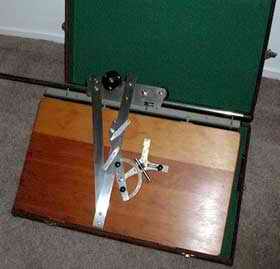
|
|
||
by Carl Matthews updated 08/31/05 |
|
|
|
|
![]()
|
Jaws 7 x 18-1/2 Opens 14 inches Weight 86 pounds
|
Jaws 4 x 14 Opens 12 inches Weight 56 pounds |
|
|
Salesman Model Sometimes called a No. 3 Jaws 3-1/2 x 9 Opens 3 inches Weight only 6 pounds |
Jaws 4 x 14 Opens 12 inches Weight 68 pounds |
|
|
Jaws 4 inches Opens 6 inches Weight 100 pounds |
Jaws 3 inches Opens 5 inches Weight 55 pounds |
|
|
Jaws 7 x 12 inches Opens approx. 14 inches Weight unknown |
Jaws unknown Opens unknown Weight unknown |
|
|
Size unknown
|
Early Emmert or Patternmaker's Copy?
|
|
 |
|
|
|
Emmert Portable Drafting Machine
|
Vintage "Emmert Adjustable Drawing Board Vertical or Horizontal", made in Waynesboro, Pa. The vertical drafting board with a drafting machine attached is 78" x 53", a flat work table on the opposite side has a work surface of 84" x 40 1/2" with a small work table that also slides out from under the work table. There are also three large plan drawers under the work table. |
|
|
|
|
|
|
|
|
![]()
Turtleback Types
The Turtleback name comes from the shape of the cover on the front jaw. The Turtleback was invented by Joseph F. Emmert. Click on the picture to see additional photos of that type. |
||
|
Turtleback with One patent date, geared symbol around spindle hole, no text on front jaw. |
Turtleback with One patent date, no gear symbol, no text on front jaw. |
|
|
Turtleback with One patent date, no gear symbol, front jaw has 82 on right and usual Emmert text on left. |
Turtleback with One patent date, elongated spindle hole, front jaw has 82 on right and usual Emmert text on left. |
|
|
Turtleback with Two patent dates but 1891 scratched off, elongated spindle hole, front jaw has 82 on right and usual Emmert text on left. |
Turtleback with Two patent dates, elongated spindle hole, front jaw has 82 or 2 on right and usual Emmert text on left. |
|
|
Turtleback with Two patent dates, elongated spindle hole, front jaw has 82 on left side now with nothing on right. |
|
|
K1 or New Improved Universal TypesThe "New Improved" Universal types are sometimes called "K1" because of the casting number on the front jaw. Casting numbers are part numbers used to aid in assembly of the vise. The K1 vise was invented by Victor R. Koontz. Click on the picture to see additional photos of that type. |
||
|
Victor Tool Co. K1 Universal with short vise dogs, no cam, and high-low ribbed collar. |
K1 Universal with short vise dogs, no cam, and high-low ribbed collar. |
|
|
K1 Universal with long vise dogs, with cam added, and high-low ribbed collar. |
K1 Universal added vertical rib on front jaw behind collar. |
|
|
|
K1 Universal with 4 rib collar. |
K1 Universal added extra reinforcement at base of vise dogs and now has the standard 8 rib triangular fin collar. |
|
|
||
|
|
Type U6
K1 Universal added extra V shaped reinforcement
on jaws and now has a plastic knob on the cam. |
|
![]()
This site was last updated 01/02/04